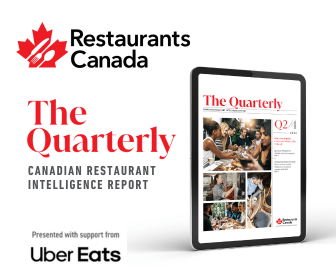Virtual Reality for Real Restaurateurs
There are arguably only three activities that engage all five of our senses, and cooking and eating are two of them. Restaurants provide a feast for the senses. From a steaming bowl of noodles to an ice-cold milkshake, it’s the sight, sound, smell, taste and texture of a menu item that add up to “delicious.” And then there’s that x-factor; the personality of your restaurant and the environment created for your guests.
Can technology replicate the intricacies of a satisfying dining experience? The world of virtual reality, or VR, is getting close. Most people associate virtual and augmented reality (AR) with flight simulators and video gaming, but they’re moving mainstream, and quickly.
In simple terms, virtual reality manipulates your senses to take you to an entirely different, computer-generated world, while augmented reality layers computer graphics on top of the world you’re in (think Pokémon GO).
Alan Smithson is CEO of MetaVRse, a collective of virtual and augmented reality experts that develops business applications and experiences for companies in a wide variety of industries. He predicts that VR and AR will be as revolutionary as the printing press was in its day. “We’re not just changing from a 1080 screen to a 4K screen. With VR we’re changing fundamentally how humans communicate,” he says.
Think about it this way: the internet, social media and mobile phones have dramatically changed the way you do business—from marketing to operations to menu development. VR and AR will change things again, in ways we can’t even imagine. The movement has already started.
Honeygrow, a Philadelphia-based chain of casual restaurants, recently launched an employee orientation program in VR. New hires don a VR headset and enter a virtual Honeygrow restaurant where the company founder welcomes them before they begin their interactive training. The fact that Honeygrow customers can watch as employees complete their VR training makes this about marketing, as much as employee recruitment and retention. What better way to send a message that your restaurant is a cool place to be, for employees as well as for customers?
KFC recently launched a VR escape room where employees must perfect the iconic Original Recipe fried chicken before they can exit. Colonel Sanders makes an appearance, providing hints and clues along the way.
It’s early going, but the value proposition of VR training is compelling. “When you’re in VR you can’t be on your phone. There are zero distractions,” Smithson says. “With the headset, you can track where (trainees) are looking, so you can have metrics on were they looking in the right spot or were they even paying attention. This takes things to a whole new level for trainers.”
And when you’re competing for talent, the “cool factor” doesn’t hurt either. Which brings us to Sublimotion (www.sublimotionibiza.com), a “gastronomic performance experience” based in the Hard Rock Hotel Ibiza that operates under the leadership of Michelin chef Paco Roncero. Sublimotion blends augmented and virtual reality with gastronomy, the arts, technology and illusion, and transports diners into scenes ranging from an early 20th-century cabaret, to an avant-garde future, to the heart of south-east Asia.
Most restaurants won’t go this far down the path of VR and AR—not yet, at least—but they will likely be drawn to the operational efficiencies: Product experts located hundreds of kilometres away who can see what you’re seeing and talk you through an equipment repair in real time; screens that suggest how best to reconfigure your restaurant to accommodate customers during peak times or special events.
For now, most AR and VR is marketing-driven. “Because it’s such a nascent early time, marketing departments are the only ones that are saying ‘yeah, we’ll try it! It’s cool, let’s go!’” says Smithson.
AR menus are a case in point. A platform called Kabaq (kabaq.io) allows diners to preview menu items in 3D, via their AR-enabled smart phones. Restaurants scan the food items ahead of time using a special type of photography.
MetaVRse has created a proof-of-concept AR menu for Boston Pizza (to see it, search “Boston Pizza augmented reality” on YouTube). The AR is triggered when guests open the proof-of-concept Boston Pizza app on their AR-enabled phone, and hover the camera over a real-life Boston Pizza menu. Menu items pop up in 3D, complete with ingredient and nutrition information, along with other interactive features.
Now that cellphones like the iPhone 8, Samsung Galaxy s8 and Google Pixel have the camera quality and processing power to enable VR and AR, the momentum toward mass adoption is growing.
“The industry has gone from literally zero two years ago to $6.5 billion last year to $14 billion this year,” says Smithson. “By Q2 next year there will be 1.5 billion smart phones enabled with very high quality augmented reality. Five years from now we’ll go from mobile phones to just having a pair of glasses on our face, and those glasses will augment the world we’re in, all the time.”
Smithson foresees a day coming soon when glasses will give us super-human vision. If you squint, they give you super-powered zoom. Blink twice and they take a photo. Blink three times, they record video. Plus, they’ll track where you’re looking and render things into your world.
“So imagine walking down the street and you see a restaurant, and outside of the restaurant floating in midair is the menu,” he says. “And you can see what the plates are like, and there may be a little animation, a little hologram, welcoming you to the restaurant.”
And you’ll likely be able to smell that delicious daily special with the advent of digital scent machines like Cyrano, launched recently by Vapor Communications.
There are some practical advantages to VR and AR in a country as culturally and ethnically diverse as Canada, says Rad Dockery, Chief Innovation Officer at Unifai Solutions, a company that helps businesses transform through the successful adoption of disruptive artificial intelligence (AI) solutions. “It’s very important to look at shifting demographics and who you’re interacting with,” he notes. “Can your new AR/VR experience support other languages? Can you take your menu and roam your camera over it and have it translated into multiple languages? We have record numbers of visitors coming from China right now. If they see someone in AR talking in Mandarin about one of your dishes, it’s a thing that says we appreciate you.”
Social impact is another potential feature of VR and AR that shouldn’t be overlooked, says Dockery. Issues like food waste, food banks and income disparity matter more and more to guests and employees, particularly millennials. “Through your VR app, guests can click to see what you’re doing to help people who are hungry. That’s one example. I’m not saying you should become a social agency, but if you can tap into partnerships and use technology to work with a local charity, that’s something to think about.”
The question is, what will be the “killer app” that propels VR and AR technology from the margins to the mainstream? If the killer app for your phone is your email, Facebook, Instagram, Snapchat or another social media platform, what will it be for VR/AR glasses?
“Whoever figures out how to draw up a hologram of your spouse or children next to you so you can have a conversation with them, they’re going to win,” says Smithson. That day may be closer than you think. Microsoft’s Holoportation platform transmits 3D models of real people into real spaces in real time. You can see how this virtual teleportation works by searching “holoportation” on YouTube.
Even with these jaw-dropping advances in technology, success still comes down to people. “There are going to be shifts in every industry. However, the number one skill that’s still going to be required is that people skill, more than ever before,” says Dockery. “The restaurants, employees and supply chains that best understand people will implement the right technology that will help their business flourish.”
Your VR/AR strategy should begin with your employees. Start by asking them what tools they need to be more passionate and productive, says Dockery. “Focus on the experience you want your customers and your partners to have, and the tools you want to give your employees to deliver that. Deal with step one. As you go along the technology path you’ve got to have very open communication with your team, your partners and your investors.”
Smithson’s advice is to get in early, start with small pilots and work your way up to something that revolutionizes your industry. “Partner with start-ups. They’re doing a lot of cool things, partner with them.”
One notable example is Project Nourished by think tank Kokiri Lab in Los Angeles. This virtual reality gastronomic experience has an intriguing promise: “What if you can eat anything you want without regret.” By replicating the sounds, sights, smells, textures and tastes of various meals, it allows diners to enjoy the experience of eating any food, regardless of food intolerances or allergies. It may seem counter-intuitive, but Project Nourished has applications for foodservice providers. The developers see potential for instilling healthy eating habits, elder care, allergy management and more. You can see how it works at projectnourished.com.
The revolution in VR and AR is underway. Stay connected, imagine the possibilities for your business and make sure you have partners and suppliers who are equally immersed in your world.
How to Get Started
Small budget
You can make a VR training experience or a VR customer-facing experience just by buying a 360-degree camera such as the Gear 360, which retails for around $300. “Put it on a little tripod stand and take 360 degree video of whatever it is you want to show people, and then you can show that in VR right away,” says Alan Smithson. “Don’t move the camera, because the second you start moving the camera you’re going to make people sick.”
Big budget
Start by asking, what is the message I want to get across, how important is it and how much money do I want to spend? Making an augmented reality menu, for example, costs around $20,000-$25,000. You can also book a two-day workshop with MetaVRse that costs around $25,000. You get to try all the latest VR and AR technology; learn about the state of VR and use cases in foodservice; imagine how this technology could work for you, and then narrow down the list to one project.
Survey Says
Fifty-three per cent of restaurant operators say restaurant design/flow optimization via virtual reality will be mainstream or in mass adoption by 2025.
Operators’ other top uses for VR:
- Staff training
- Kitchen design
- Guest entertainment
- Enhancing guest experience
Source: Restaurant 2025 Report by Oracle Hospitality
Food, art and motion
With Project Nourished, the creative minds at Kokiri Lab have perfected the recipe for a multi-sensory, virtual-reality dining experience. But that’s just the beginning, according to founder Jinsoo An. In 2018, his team will unveil practical solutions for restaurant owners and chefs who want to incorporate augmented and virtual reality in ways that are “tasteful, elegant and easy to use,” he says.
“We will provide a full suite of what we call mixed-reality tableware for both chefs and content creators alike. It’s going to be really exciting to see chefs and artists collaborating together to create something breathtaking and never done before.”
Mixed reality is similar to augmented reality, but the computer graphics interact with the real world. These dining experiences “will not only enhance and beautify the eating experience, but will allow chefs to tell a deeper story with art and motion,” says An. His research shows that customers are demanding “more visceral experiences” when it comes to eating. “They are getting more used to looking at food porn and re-imagining food through Instagram and YouTube. We describe this phenomenon or desire to eat things that are not quite real as hyper-normalization of food.”
In a study of 20 randomly selected participants in the Los Angeles area, Kokiri Lab found that participants who dined with the lab’s augmented reality technology were significantly more satisfied during and after the dining experience than those who dined normally.
DIG IN
You can learn more about augmented reality, virtual reality and other cutting-edge technologies at RC Show 2018: Innovation Unleashed, Feb 25 – 27, 2018 in Toronto. Alan Smithson of MetaVRse is speaking, and there will be plenty of exhibitors with the latest technology for your restaurant.
Visit rcshow.com









